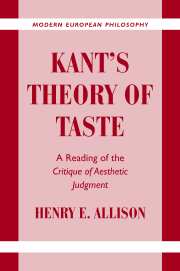Book contents
- Frontmatter
- Contents
- Acknowledgments
- Note on Sources and Key to Abbreviations and Translations
- Introduction
- PART I KANT'S CONCEPTION OF REFLECTIVE JUDGMENT
- 1 Reflective Judgment and the Purposiveness of Nature
- 2 Reflection and Taste in the Introductions
- PART II THE QUID FACTI AND THE QUID JURIS IN THE DOMAIN OF TASTE
- PART III THE MORAL AND SYSTEMATIC SIGNIFICANCE OF TASTE
- PART IV PARERGA TO THE THEORY OF TASTE
- Notes
- Bibliography
- Index
1 - Reflective Judgment and the Purposiveness of Nature
Published online by Cambridge University Press: 18 January 2010
- Frontmatter
- Contents
- Acknowledgments
- Note on Sources and Key to Abbreviations and Translations
- Introduction
- PART I KANT'S CONCEPTION OF REFLECTIVE JUDGMENT
- 1 Reflective Judgment and the Purposiveness of Nature
- 2 Reflection and Taste in the Introductions
- PART II THE QUID FACTI AND THE QUID JURIS IN THE DOMAIN OF TASTE
- PART III THE MORAL AND SYSTEMATIC SIGNIFICANCE OF TASTE
- PART IV PARERGA TO THE THEORY OF TASTE
- Notes
- Bibliography
- Index
Summary
As the title indicates, the Critique of Judgment is concerned with the faculty of judgment [Urteilskraft]. Following a long tradition, Kant assumes that judgment, together with understanding and reason, constitute the three “higher” cognitive faculties (sensibility being the “lower” faculty), and the question he poses at the beginning of both Introductions is whether a separate critique of this faculty is necessary or, indeed, possible. To anticipate a topic to be explored at length later in this study, the necessity for such a critique stems from the mediating function that judgment supposedly plays between the faculties of understanding and reason, which were the main concerns of the first and second Critiques respectively.
What is of immediate interest, however, is not so much the systematic function that judgment is supposed to play in the overall critical enterprise, but rather the condition under which it is alone capable of a critique in the first place. As already indicated in the Introduction, this condition is that it must be the source of some claims that rest on an a priori principle unique to judgment as a faculty (otherwise there would be nothing stemming specifically from judgment requiring a transcendental critique).
In the Critique of Aesthetic Judgment (the first part of the Critique of Judgment), Kant argues that judgments of beauty fit this description, since they lay claim to a certain kind of universality and necessity. But the initial problem with which Kant deals in the Introductions is the direct outgrowth of the first two Critiques, namely that judgment, in contrast to both the understanding, which is normative with respect to nature, and reason (here understood as practical reason), which is normative with respect to freedom), does not appear to have its own sphere of normativity.
- Type
- Chapter
- Information
- Kant's Theory of TasteA Reading of the Critique of Aesthetic Judgment, pp. 13 - 42Publisher: Cambridge University PressPrint publication year: 2001

